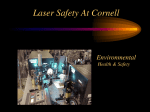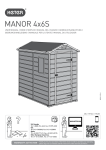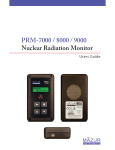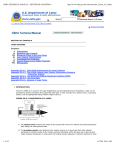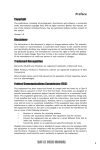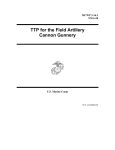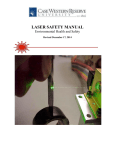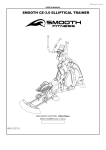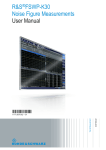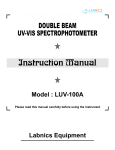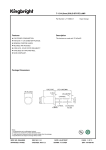Download CDRH/IEC - Who it Applies To?
Transcript
Laser Safety Practical Application Seminar PAS Session 6: CDRH/IEC - Who it Applies To? Nikolay Stoev & Tom Lieb Course Instructors Tuesday, 2:00PM Room: Salon A-D CDRH / IEC - Who it Applies to? IEC laser product safety standards Nikolay Stoev, P. Eng., CLSO VALKOM Laser Consulting Toronto, Canada [email protected] Practical Applications Seminar ILSC 2007 • San Francisco, CA Principles of laser product safety z Basic definitions What are we talking about? z Duties and responsibilities of laser product manufacturers Does that apply to me? z Applicable standards and regulations Stay informed, things change z Manufacturing requirements. Engineering specifications, labelling and informational requirements Why? “I am shipping my laser product tomorrow. What should I do about laser safety compliance?” Basic definitions • Laser product - any device that constitutes, incorporates or is intended to incorporate a laser or laser system (unless sold as component) • Manufacturer - any person or organization involved in the business of making, assembling, or importing of laser products • Human access – intercepting the beam for low power lasers and reflection by an imaginary flat surface through any opening for high power lasers 1 Types of laser products Laser source: instrument, the main function of which is to produce laser radiation at a desired wavelength, desired power, pulse energy, emission mode, etc. Laser product: any device, instrument, system, etc., in which laser radiation is used as a means to achieve the desired function (e.g. illuminate, scan, excite, cut, weld, mark, transmit optical signal, perform a diagnostic test or therapeutic procedure, etc.) The optical spectrum and common lasers X-rays UV Visible 1nm 400 nm Infrared 700 nm Microwaves 1 mm Ruby Argon Excimer CO2 Nd:YAG 694 nm 488 nm ArF 193 nm 514 nm HeNe 10.6 μm 1064 nm 633 nm KrF 248 nm InGaAsP, Er InGaAlP XeCl 308 nm 1310 nm, 1550 nm 635-660 nm GaAlAs, GaAs, Nd:YAG Nytrogen Ti:Sapphire 532 nm 337 nm 780 nm - 980 nm Laser Product Manufacturers must: • Design and manufacture laser products to be in compliance with applicable product safety standards • Classify the laser product according to the applicable standard(s) • Meet the engineering (performance), labelling and informational requirements for the assigned class • Test the laser products to assure/confirm their compliance • Certify the product compliance 2 Associated issues z z z z z z z z Cost and time (include in budget!) Different, not always mutually accepted standards IEC/EN laser safety standard applies to LEDs Apparent Source Size affects classification Single fault conditions Scanning lasers (patterns, variable output) Converging (focused) beams Accuracy of measurements (e.g. test geometry for diverging sources – apparent source size and location, measurement aperture distance) Selection of Laser/LED components z z z z z z Product design (housing, interlocks, etc.) Necessity for physical measurements Applicability of standards or exemptions from Amount of information to be provided with final product, labels, etc. Wavelength, max emitted optical power – key factors Attention with certified laser/LED components: – Use of certified components does not mean that the final product is compliant – Certification may be limited (e.g. Class 1 for driving current < Imax) – Testing and compliance with label and information requirements may still be required Laser Product Standards • Manufacturer standards – define the requirements laser product manufacturers must meet when developing, manufacturing and selling laser products (e.g. IEC/EN/CSA 60825-1, IEC/EN 60825-2, 21 CFR Parts 1040.10 and 1040.11, IEC/EN 60601-2-22, ISO 11553, etc.) • User standards – provide guidance for the safe use of lasers and laser systems according to their relative hazards (e.g. ANSI Z136.1 to .6, IEC 60825-1 Section 3, 60825-14) 3 IEC 60825 Series: 1. IEC 60825-1+A1+A2 Safety of Laser Products - Part 1: Equipment classification, requirements and user’s guide 2. IEC 60825-2 Safety of Laser Products - Part 2: Safety of optical fibre communication systems, Ed. 3.0:2004+ A1:2006-11 3. IEC TR 60825-3 Safety of Laser Products - Part 3: Guidance for laser displays and shows 4. IEC 60825-4 Safety of Laser Products - Part 4: Laser guards (new edition 2 published 2006-08) IEC 60825 Series: 5. IEC TR 60825-5 Safety of Laser Products – Part 5: Manufacturer’s Checklist for IEC 60825-1 (2003-06). New bilingual (En/Fr) edition published 2005-11. 6. IEC TR 60825-8 Safety of Laser Products - Part 8: Guidelines for the safe use of laser beams on humans (new edition 2 published 2006-12) 7. IEC TR 60825-9 Safety of Laser Products - Part 9: Compilation of MPE to incoherent optical radiation (1999) 8. IEC TR 60825-10 Safety of Laser Products - Part 10: Laser safety application guidelines and explanatory notes (2002-02) IEC 60825 Series: 9. IEC 60825-12 Part 12: Safety of free space optical communication systems used for transmission of information (2005-01). 10. IEC 60825-13 Part 13: Measurements for classification of laser products. New standard published 2006-08 11. IEC TR 60825-14 Part 14: A user guide. Provides guidance on best practice in the safe use of laser products that conform to IEC 60825-1. Unlike IEC 608251, this document does not cover LEDs (2004-02). 4 IEC/EN standards associated with IEC 60825-1: 12. IEC 60601-2-22, Medical electrical equipment - Part 2: Particular Requirements for the Safety of Diagnostic and Therapeutic Laser Equipment. Applies to Class 3B and Class 4 medical laser products (1995-11). 13. IEC/EN 60065, Audio, video and similar electronic apparatus – Safety requirements 14. IEC/EN 60950, Safety of information technology equipment. 15. IEC/EN 61010, Safety requirements for electrical equipment for measurement, control and laboratory use – Part 1: General requirements IEC/EN standards associated with IEC 60825-1 : 16. ISO 11553, Safety of machinery – Laser processing machines – Safety requirements 17. EN 12626, Safety of machinery – Laser processing machines – Safety requirements (modified ISO 11553) 18. IEC 62115 Safety of electric toys (2004) 19. IEC 60079-0:2004 Electrical apparatus for explosive gas atmospheres. General requirements 20. IEC 62471/CIE S009 Photobiological safety of lamps and lamp systems 21. IEC 61040, Power and energy measuring detectors, instruments and equipment for laser radiation Applicability of IEC 60825-1 z z z z Applies to safety of laser products Light emitting diodes (LED) are included whenever the word “laser” is used. NOTE: LEDs will be excluded from the scope in Edition 2 of IEC 60825-1 Laser products sold to other manufacturers for use as components in a system are not subject to the standard, since the final product will itself be subject to this standard. Any product is exempt from the standard if: – classification by the manufacturer according to the prescribed test and classification procedures shows that the emission levels do not exceed the limits for Class 1 under all conditions of operation, maintenance, service and failure, and – it does not contain an embedded laser or LED. 5 Applicability of IEC 60825-1 z Where a laser system forms a part of equipment which is subject to another IEC standard for safety, e.g.: - IEC 60601-2-22 for medical equipment IEC 60950 for IT equipment IEC 60065 for audio and video equipment the standard applies in accordance with IEC Guide 104. For example, IEC 60065 exempts LEDs from IEC 60825-1 z If the laser system is operable when removed from the equipment, all the requirements of this standard will apply to the removed unit z If no product safety standard is applicable, then IEC 61010-1 applies. Applicability of IEC/EN 60825-1 Applicability issues in Europe EN standards (amendments) have withdrawal date (dow), which is typically three years after the publication of a newer revision (including Amendment 2). IEC standards do not have withdrawal date. A1:2002 to EN 60825-1 replaces A11:1996. Certificates with A11 were only valid until July 1, 2005. As of July 1, 2005 only the version including Amendment 2 is accepted. However the previous version was still valid for testing until then. NOTE: Æ Verify if certificates are updated. IEC/EN 60825-1: Manufacturing Requirements More definitions Accessible Emission Limit (AEL): The maximum accessible emission level of laser radiation permitted within a particular class. Embedded laser product: laser product which, because of engineering features limiting the accessible emissions, has been assigned a class number lower than the inherent capability of the incorporated laser. Typical example: laser printer (Class 1 product) using a Class 3B laser diode. Removable laser system: Embedded laser product or system that can be removed from its protective housing and operated without modification 6 IEC/EN 60825-1: Manufacturing Requirements More definitions Human access: a) Capability for a part of the human body to meet hazardous laser radiation either as emitted from an aperture, or capability for a straight 12 mm diameter probe up to 80 mm long to intercept laser radiation of Class 2, 2M or 3R b) For levels of laser radiation within a housing that exceed the limits in a) the capability for any part of the human body to meet laser radiation that can be reflected directly by any single flat surface from the interior of the product through any opening in its protective housing IEC/EN 60825-1: Manufacturing Requirements z Classification of laser products It is the responsibility of the manufacturer or his agent to provide correct classification of a laser product. z The product is classified on the basis of the accessible laser radiation during operation which results in its allocation to the highest appropriate class according to the AELs for each class. z Classification is based on operation. Accessible emission during maintenance and service defines the necessity of interlocks, labels and information for the user, but does not affect classification IEC/EN 60825-1: Manufacturing Requirements Classification of laser products Factors affecting the classification of a product: Radiation at a single wavelength Radiation at multiple wavelengths Human access Radiation from extended sources (components selection) angular subtense apparent source Exposure duration (applicable time basis) Repetitively pulsed or modulated lasers Scanning lasers (rotational, sinusoidal) 7 IEC/EN 60825-1: Manufacturing Requirements Tests and Measurements 1. Tests during operation are used to determine the classification 2. Tests during operation, maintenance and service are used to to determine the requirements for safety interlocks, labels and information for the user 3. Tests must be made under each and every reasonably foreseeable single fault condition 4. Measurements of laser radiation may be necessary 5. Measurements must follow prescribed conditions and measurement geometry Distinction between Class 1 and Class 1M is based on the measurement geometry, not the applicable AEL! IEC/EN 60825-1: Manufacturing Requirements Engineering Specifications 1. Modification 2. Protective housing (all classes) 2.1 Service access (non-interlocked panels) 2.2 Removable laser systems 3. Access panels and safety interlocks. Interlock required when: • the access panel is intended to be removed during maintenance or operation, and • the accessible laser emission after the panel removal is: - Class 3R, 3B or 4 for product classes 1, 1M, 2 and 2M - Class 3B or 4 for all product classes IEC/EN 60825-1: Manufacturing Requirements Engineering Specifications 4. Remote interlock connector (Class 3B and 4) 5. Key control (3B and 4) 6. Laser radiation emission warning (3B, 4, invisible 3R) 7. Beam stop or attenuator (3B and 4) 8. Controls location 9. Viewing optics 10. Scanning safeguard 11. Alignement aids 12. Walk-in access 13. Environmental conditions 14. Protection against other hazards 8 IEC/EN 60825-1: Manufacturing Requirements Labelling Requirements 1. Labels must be permanently fixed, legible and clearly visible during operation, maintenance and service according to their purpose. Check the design - CDRH labels not valid for IEC! 2. Product class label - specific text 3. Aperture label (3R, 3B and 4) 4. Access panel labels (more than one may be needed): - non-interlocked panels - interlocked panels 5. Visible/invisible radiation IEC/EN 60825-1: Manufacturing Requirements Information Requirements 1. Information to the user (operation manual): a) instructions for safe use, including warnings b) For Class 1M and 2M an additional warning is required c) Beam divergence pulse duration and maximum output; similar information for embedded and other incorporated laser products d) Reproductions of all labels and their position on the product e) Indication of all locations of laser apertures f) List of controls and adjustments for operation and maintenance with a specific “Caution” statement g) laser energy source requirements IEC/EN 60825-1: Manufacturing Requirements Information Requirements 2. Purchasing information The safety classification of each laser product must be stated 3. Servicing information - instructions for service adjustments and procedures - clear warnings to avoid exposure to laser and other hazards - a schedule of maintenance to keep the product in compliance - list of controls to increase accessible levels - location of displaceable portions of housing - protective procedures for service personnel - reproduction of all applicable labels 9 IEC/EN 60825-1: Manufacturing Requirements Additional requirements for specific laser products 1. Medical laser products Each medical laser product must comply with all the applicable requirements for laser products of its class. In addition any Class 3B or Class 4 medical laser product must comply with IEC 60601-2-22. 2. Other applicable parts of the standard series IEC 60825: 60825-2: Optical fibre communication systems 60825-4: Laser guards 60825-12: Free Space Optical Communication Systems 60825-9: MPE for incoherent radiation IEC 60825-2 applicability and requirements • • • • • Applies to fiber optic communication systems Accessible locations (controlled, restricted and unrestricted access) Engineering specifications • Cable design • Cable connectors and positioning • APR (Automatic power reduction) Additional marking and labelling of accessible locations Additional information requirements for manufacturers, installation, operating and service organizations Applicability of IEC 60601-2-22 z IEC 60601-2-22 Medical Electrical Equipment Part 2: Particular Requirements for the Safety of Diagnostic and Therapeutic Laser Equipment z Extension of IEC 60601-1 standard for safety of medical electrical equipment Provides additions or modifications to some IEC 60601-1 clauses Provides additions or modifications to some IEC 60825-1 clauses z z z Ed. 3.0 work underway in TC 76. Status as of Dec 2006: Approved for circulation as FDIS. Expected publication: 2007-05 10 Applicability of IEC 601-2-22 Scope: z Applies to Class 3B or Class 4 Laser Equipment for medical applications z Laser Equipment for medical application classified as a Class 1, 2 or 3A is covered by IEC 60601-1 and IEC 60825 Object: z To specify particular requirements for the safety of Laser Equipment classified as a Class 3B or Class 4 Laser Product IEC 601-2-22 requirements z z z z z z z z z Additional terminology and specific definitions Extension of single fault conditions and components with limited reliability Label exemption for handpieces/applicators requiring sterilization Additional user information requirements Information and guidance for regular calibration of the laser output Laser “Ready” warning (additional to laser “ON”) Beam aiming device, target indicating device Laser output indication and monitoring (closed loop or warning) Emergency laser stop IEC 60825-4 Laser Guards Rationale At low power levels, the selection of material and thickness of laser shields is determined by the need to provide sufficient optical attenuation. There is no concern about the shield integrity. At higher levels, the laser beam is able to destroy the guard material and the laser radiation may penetrate the normally opaque shield material. The integrity of the protective shields becomes a concern! Laser 11 IEC 60825-4 Laser Guards Scope • Specifies the requirements for laser guards, permanent and temporary (for example for service), that enclose the process zone of a laser processing machine, and specifications for proprietary laser guards • Applies to all component parts of a guard including clear (visibly transmitting) screens and viewing windows, panels, laser curtains and walls. • Indicates: - how to assess and specify the protective properties of a laser guard; and - how to select a laser guard IEC 60825-4 Laser Guards Summary of requirements Laser processing machines • Design requirements • Performance requirements • Validation • User information Proprietary laser guards • Design requirements • Performance requirements • Specification requirements • Test requirements • Labelling requirements • User information IEC 60825-12 Safety of free space optical communication systems used for transmission of information Scope • Provides requirements and specific guidance for the manufacture and safe use of laser products and systems used for point-to-point or point-to-multipoint free space optical data transmission • It only addresses the open beam portion of the system • Does not apply to systems designed for transmitting optical power for material processing or medical treatment • Does not apply to the use of systems in explosive atmospheres 12 IEC 60825-12 Safety of free space optical communication systems used for transmission of information Objectives • Provide information to protect people from potentially hazardous optical radiation produced by free space optical communication systems (FSOCS) by: • Specifying engineering controls and requirements, administrative controls and work practices according to the degree of the hazard • Specify requirements for manufacturing, installation, service and operating organizations in order to: • Establish procedures and provide written information so that proper precautions can be adopted. IEC 60825-12 Safety of free space optical communication systems used for transmission of information Summary • Imposes restrictions on FSOCS for product classes and access levels that are dependent on the location type(s), in which they are installed (restricted, non-restricted and controlled) • The operating organization has the ultimate responsibility for the installation, service, maintenance and safe use of the end-to-end FSOC system • Includes requirements for transmitter manufacturers, installers and service organizations • Requires that the manufacturer explicitly defines the area location type and state whether the FSOCS is intended for installation in a unrestricted, restricted, or controlled access location type IEC 60825-12 Safety of free space optical communication systems used for transmission of information Summary • Provides performance requirements for Automated power reductions (APR) • Defines the method for determination of the access level by the operating organization • Includes provision for Installation Protection Systems (IPS), a feature similar to an APR system but not integrated with an FSOCS transmitter by a manufacturer. Instead, an installer may incorporate an IPS with an FSOCS transmitter so that the accessible power at defined locations is reduced to a specific level within a specific time • Includes requirements for warning signs for the access levels existing at the different types of locations 13 IEC 60825-12 Safety of free space optical communication systems used for transmission of information Commercial structures Controlled locations 2.5 m R e s t r I c t e d Locked door Unrestricted Inaccessible Space 3m Restricted 3m Unrestricted IEC 60825-12 Safety of free space optical communication systems used for transmission of information Residential Areas Unrestricted Restricted 3m Unrestricted IEC TR 60825-9 Compilation of MPE to incoherent optical radiation Scope and object • To provide guidance for the protection from incoherent optical radiation in the range from 180 nm to 1 mm by indicating levels, which are believed to be safe for most individuals (exposure below these levels will create no adverse effects) • To provide procedures and methods how the level of optical radiation should be measured and evaluated for the purpose of comparison with the applicable MPE 14 IEC TR 60825-9 Compilation of MPE to incoherent optical radiation Scope and object – notes: • The report reconciles current MPE values for exposure to eye and skin to incoherent optical radiation from artificial sources (may also be used for sunlight evaluation) in the range 180 – 3000 nm (values for 3000nm to 1 mm are currently undefined) • MPE values are based on best available experimental data and ICNIRP guidelines • MPE values should be used as guides only and not regarded as a precise line between safe and dangerous levels • Not applicable for optical radiation medical treatment and to LEDs • Exposures to MPE levels may be uncomfortable to view or feel • In UV-B and UV-C the MPEs are close to the levels producing minimally detectable biological changes in the surface corneal cells Most common failures: Engineering specifications: • housing design - openings allowing human access • inadequate interlock design • remote interlock (confused with housing interlock or not readily accessible) Labels • incorrect wording • incorrect IEC 60825-1 design (black frame) • missing or incorrect information (laser output or standard name) • missing or incorrect CDRH certification and identification labels • mismatched labels and text (e.g. class warning labels used instead of access panel warning labels or vice versa) • Labels not reproduced in the user manual Most common failures: Informational requirements: User and/or service manuals: • missing or illegible label reproductions • missing indication of label location on the product • laser aperture not indicated • missing laser output information • missing “Caution” statement • missing schedule of maintenance to keep the product in compliance Purchasing literature (brochures, specification sheets, flyers): • missing Class statement (or warning label reproduction for CDRH) 15 Most common failures: Laser product reports for CDRH: • classification not properly documented (with test results, etc.) • location of labels (do not put labels on battery or other covers!) • user/service information deficiencies • missing supporting documentation: • laser paths diagrams • interlock mechanical or electrical diagrams • quality control sample documents • measurement equipment documentation and calibration • missing US agent (for importers) 16 US LASER PRODUCT and WORKPLACE SAFETY REGULATIONS WHO, WHAT and WHY FDA/CDRH OSHA/ANSI Essence of Safety Requirements for Laser Products ¾ Are You a Laser Manufacturer? z z US standards and regulations apply the first step : which category laser function; manufacturer or user or both ¾ Any electronic product that incorporates or is intended to incorporate a laser is a laser product Essence of Safety Requirements for Laser Products z z z IF YOU make, modify or import such a product, YOU ARE a laser manufacturer and are subject to the requirements. frequently misunderstand by those who import products, or who are third party integrators if integrator marries a laser with handling equipment, for example, he becomes a laser product manufacturer. 1 Essence of Safety Requirements for Laser Products ¾ if there are lasers in your facility you are subject to the user’ user’s laser safety requirements. requirements. ¾ Will outline the critical requirements for both manufacturers and users. Essence of Safety Requirements for Laser Products ¾ United States Standards Product standards, standards, or the standards which place responsibility and requirements on manufacturers, are set forth in United States Title 21 Code of Federal Regulation, subsubchapter J. , including the Federal Laser Product performance Standard (FLPPS) 1040.10 Essence of Safety Requirements for Laser Products ¾ ¾ These requirements administered and enforced by the Food and Drug Administration/Center for Devices and Radiological Health (FDA/CDRH ), under the US Department of Health and Human Services, (or DHHS). manufacturers must comply with all the paragraphs; product performance features contained CFR 1040, the Federal Laser Product Performance Standard (FLPPS) 2 Essence of Safety Requirements for Laser Processing ¾ Workplace safety, (user safety), on the other hand, is regulated under Title 29, Code of Federal Regulation, (29 CFR) under the auspices of the Department of Labor (DoL) and the Occupational Safety and Health Administration (OSHA). ¾ This distinct separation between provider and user requirements, not separate, outside the US (or with one standard in the US: ANSI B11.21) Essence of Safety Requirements for Laser Products FDA 21 CFR IEC/EN 60825 ANSI B11.21 FAA 7400.2 SAE-G10 Laser Z136.6 Outdoors Z136.1 Main ANSI OSHA Pub. 8-1.7 Ch. 17 Z136.2 Fiber NFPA Z136.5 Schools Z136.3 Medical National Electric Code Z136.7 Eyewear Draft ACGIH 115 Fire Z136.4 Measure Draft STATES CRCPD Model State Essence of Safety Requirements for Laser Products ¾ Many other countries, other than the US and EU members, will accept or adopt either IEC 60825 or 21 CFR 1040. ¾ Acceptance of the IEC 60825 as valid has led the FDA/CDRH to amend the 21 CFR to achieve harmonization with IEC 60825. 3 Essence of Safety Requirements for Laser Products ¾ Until Amended FDA/CDRH has issued Laser Policy Notice No. 50, permits manufacturers to comply with the US FLPPS, by complying with certain paragraphs of IEC 60825 ¾ Reduces the burden of manufacturers from making two separate product lines . Essence of Safety Requirements for Laser Products ¾ ¾ ¾ Laser workplace safety, in the United States, no written specific US Federal Standards (except for the use of lasers in the Construction industry under 29 CFR 1954), OSHA has adopted a practice of enforcement under the General Duty Clause (Clause 5 (a)(1) of Public Law 9191-596) Requires employers to provide a safe work place for employees, to “accepted industry standards” standards” Essence of Safety Requirements for Laser Products ¾ The most accepted standard for workplace safety of lasers (in the US) is American National Standards Institute (ANSI) Z 136 series. ¾ OSHA enforcement is documented by the issuance of OSHA Instructional Publication 88-1.7 (5 Aug '91) 4 Essence of Safety Requirements for Laser Products ¾ Historically, there were differences in classification of hazards between user standards and product standards, and between the US and international versions. ¾ Differences have been somewhat resolved, and a cohesive set of guidelines and requirements has been the result. Essence of Safety Requirements for Laser Products ¾ Generally, the standards have some global agreement on laser hazard identification, classification and control. ¾ Still keep the different perspective of product vs. product use. ¾ Product standards are based on the ACCESS Essence of Safety Requirements for Laser Products ¾ Product standards identify the hazard level in the emission of radiation from the product, and the protection of humans placing performance requirements (guards, warnings, etc.) ¾ User (workplace) standards also identify hazard levels (classes), but the control perspective is one of limiting, reducing or eliminating human EXPOSURE . 5 Essence of Safety Requirements for Laser Products ¾ The difference between ACCESS and EXPOSURE is an important concept to grasp when applying the respective standards ¾ ACCESS is the possibility, no matter how remote, of radiation becoming incident on a human. Essence of Safety Requirements for Laser Products ¾ EXPOSURE is the reality of ACCESS. z z No standard permits Exposure But product standards permit Access ¾ Preventing or limiting exposure, may consider such factors as “reasonably foreseeable” foreseeable” probability, z May use administrative controls such as barricades and personal protective equipment (PPE). Essence of Safety Requirements for Laser Products ¾ However, the control of human ACCESS requires engineering features, with specific rules on application. Protective housings, interlocks, filtered / attenuated viewports, and so on 6 Essence of Safety Requirements for Laser Products ¾ Basic cornerstone of all standards, for both user and laser products, is the concept of classification of hazards. ¾ Classifying hazards is a convenience adopted for universal understanding of degree of harmful potential of a given transmitted laser energy Essence of Safety Requirements for Laser Products ¾ ¾ In the major accepted standards, there are four (4) hazard classes. The hazard classes range from 1 to 4 (I to IV) with Class 1 being safe (no hazard) and Class 4 being the most hazardous US standards (both the Product and User) have slightly different numbering system from the international version (IEC 60825), but in essence, they agree. Essence of Safety Requirements for Laser Products Comparison of Classification Schemes between the various major standards CDRH- 21 CFR 1040 I IEC-60825-1 ed 1.2 1 ANSI-Z 136.1 IIa 1M 2 II 2 3a 1 IIIa 2M 3b IIIb 3R 4 IV 3B 4 7 Essence of Safety Requirements for Laser Products ¾ “Intermediary” Intermediary” US Standard One major US standard has both manumanufacturer (product) and workplace (user) requirements for laser processing machmachines. ¾ ANSI B11.21 Safety Requirements for Machine Tools Using a Laser for Processing Materials Essence of Safety Requirements for Laser Products ¾ In the US 21 CFR 1040: no special treatment of products for industry or use environment. z ¾ (exception special purpose products such as demonstration lasers; surveying leveling or alignment laser; or medical laser products By contrast, the IEC 60825 series addresses a number of discrete product . categories and environments Essence of Safety Requirements for Laser Products ¾ This separate treatment allows for more clarity, but adds requirements, for manufacturers of certain products. 8 Essence of Safety Requirements for Laser Products ¾ ¾ ¾ 21 CFR regulations require that manumanufacturersfacturers-ofof-record must certify that their products are in compliance with the standard; that they will remain in compliance through engineering and manufacturing controls (QA); and that they will report such compliance to the FDA/CDRH prior to the product entering commerce. Essence of Safety Requirements for Laser Products ¾ 21 CFR Parts Requirements Recordkeeping. 1000 – 1010: Administrative including Reporting and ¾ 21 CFR Parts Requirements. ¾ FDA/CDRH has also published fiftyfifty-four (54) Laser Policy Notices, which serve to clarify, interpret, or otherwise add meaning to the standard requirements. (Notice #50 permits use of IEC 6082560825-1 for compliance) 1040: Product Performance Essence of Safety Requirements for Laser Products ¾ Combination Standard: Standard: As previously noted, laser requirements standards are generally separated into “manufacturers” manufacturers” requirements or “users” users” requirements. An exception to this general statement is the one which exists in the series of safety standards on Machine Tools.: ANSI B11.21: Design, Construction, Care and Use of Laser Machine Tools 9 Essence of Safety Requirements for Laser Processing (2) Normative References (3) Definitions (1) Scope (4) Responsibilities for (4.1) Supplier (4.2) User (5) Hazard Control (5.1) Task and Hazard (4.3) User Personnel B11.TR3 Identification (5.2) Risk Assessment / Risk Reduction NFPA 79 Comply with Training and Safety Procedures B11.19 (6) Design and Construction B11.TR1 B11.TR2 B11.TR3 B11.TR4 (7) Installation, Testing, and Start-up NFPA 70 NFPA 70E NFPA 79 B11.19 (8) Safeguarding B11.TR3 (9) Operation and Maintenance Essence of Safety Requirements for Laser Products ¾ ¾ ¾ ¾ Workplace or Users’ Users’ standards, standards, in the US come under the auspices of OSHA and the department of Labor, via the use of the General Duty Clause of Public Law 9191-596, and the publication of OSHA ANSI Z 136.1, Safe Use of Lasers. ANSI Z136.7, Laser protective Eyewear and Barriers Z 136.X9 , Safe use of lasers in manufacturing Essence of Safety Requirements for Laser Products ¾ ¾ Common Requirements of Manufacturers’ Manufacturers’ Standards Protective Housing Each laser product shall have a protective housing . ¾ Master Key Control All Class IIIb (3B)and Class IV (4) lasers ¾ Emission Indicator Visible or audible signal during emission required for Class II, IIIa, IIIb and IV. (IEC = Class 3R and above) Class 3 and 4, must indicate before laser is emitted. 10 Essence of Safety Requirements for Laser Products ¾ Beam Attenuator Class II, III (a or b), and IV (IEC Class 3B and 4, only )lasers must have a permanent attached means of preventing access to the laser and collateral radiation. ¾ Location of Controls The controls must be located so that exposure to the beam is not necessary for normal operating functions Essence of Safety Requirements for Laser Products ¾ Viewing Optics All viewing optics, view ports and display screens shall at all times limit the levels of the laser and collateral radiation to less than Class I limits.. ¾ Scanning Safeguards A scan failure cannot allow the laser to increase its classification. Essence of Safety Requirements for Laser Processing ¾ ¾ Pertinent to Laser Processing Machines are the following requirements; WalkWalk-in Workstations. (IEC=) If a protective housing is equipped with an access which provides "walk"walk-in" access then: a) means shall be provided so that any person inside the housing can prevent activation of a Class 3B or Class 4 laser hazard. b) a warning device shall be situated so as to provide adequate warning of emission of Class 3R laser radiation in the wavewavelength range below 400 nm and above 700 nm, or of Class 3B or Class 4 laser radiation to any person who might be within the housing 11 Essence of Safety Requirements for Laser Processing ¾ WalkWalk-in Workstations. US Requirement is Laser Policy Notice # 37, approximately the same requirement as the IEC 6082560825-1 clause 4.12, except as follows: a) enclosure is safety interlocked and labeled as required by the FLPPS . b) a means is provided as part of the overall safety interlock scheme to detect the presence of persons within the enclosure, and/or to prevent operation of the laser when a person is inside the enclosure, AND Essence of Safety Requirements for Laser Processing ¾ The user information clearly instructs operators to avoid procedures that could give access to hazardous levels of laser radiation. Essence of Safety Requirements for Laser Products ¾ Considering Class I Protective housings. "Human Access", IEC (EN) 6082560825-1 says, in clause 3.36, human access (is): "a) Capability for a part of the human body to meet hazardous laser radiation either as emitted from an aperture, or capability for a straight 12 mm diameter probe up to 80 mm long to intercept laser radiation of Class 2, 2M or 3R, or b) For levels of laser radiation within a housing that exceed the limits in a) the capability for any part of the human body to meet hazardous laser radiation that canbe reflected directly by any single introduced flat surface from the interior of the product through any opening in its protective housing. 12 Essence of Safety Requirements for Laser Products ¾ Considering Class I Protective housings. ` 21 CFR 1040.10(b)(15) defines "Human Access" as follows: Human access means the capacity to intercept laser or collateral radiation by any part of the human body. For laser products that contain Class IIIb or IV levels of laser radiation, ‘‘human ‘‘human access’’ access’’ also means access to laser radiation that can be reflected directly by any single introduced flat surface from the interior of the product through any opening . Essence of Safety Requirements for Laser Processing . . . .in the protective housing of the product. Essence of Safety Requirements for Laser Products Common Elements of User Standards ¾ Establishing Laser Hazard Classification z 4 base hazard Classes ¾ Evaluation of Hazards, by determining z z MPE NHZ 13 Essence of Safety Requirements for Laser Products Define Control Measures ¾ Engineering Controls z z z ¾ Enclosures Interlocks Warning Systems Administrative and Procedural Control z z Authorized Personnel SOP : Alignment and Maintenance Essence of Safety Requirements for Laser Products ¾ Administrative and Procedural Control z z Training Protective Equipment • Eyewear • Barriers 14 ILSC® 2007 Laser Safety Practical Applications Seminar Evaluation Session #6: CDRH/IEC - Who it Applies To? Course Instructors: Nikolay Stoev & Tom Lieb Please rate the following: (circle) Course Overall Course Course Instructor Presentation of material Organization of material Course well paced Excellent 5 5 5 5 5 Very Good 4 4 4 4 4 Good 3 3 3 3 3 Fair 2 2 2 2 2 Would you recommend this course to others in your profession? Poor 1 1 1 1 1 yes no What was the strongest feature of the course? What was not covered that you felt should have been covered (if anything)? What would you like to hear more about next time? What was covered that left an impression/impact on you? Suggestions & Comments (for this course or courses you would like in the future): Name: (optional) Please Use Reverse Side for Additional Comments. Please return evaluation form to the Registration Desk by Wednesday afternoon or fax 407.380.5588 to LIA upon your return home. THANK YOU!

































